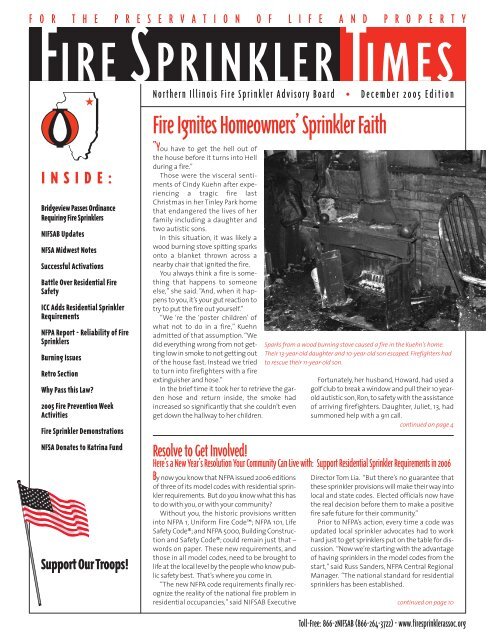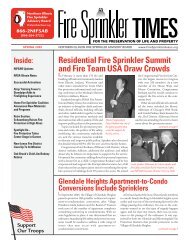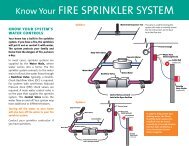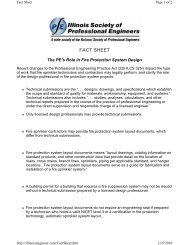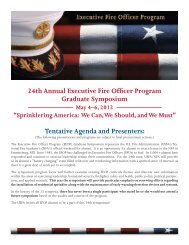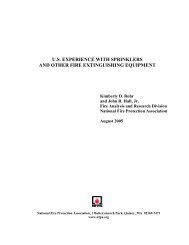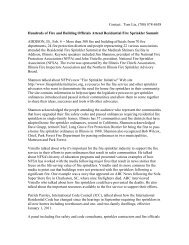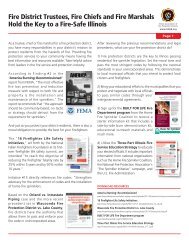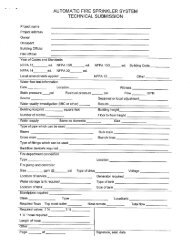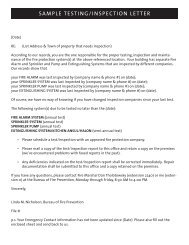#665 NLR-NIFSAB 2003-03_v3 - Northern Illinois Fire Sprinkler ...
#665 NLR-NIFSAB 2003-03_v3 - Northern Illinois Fire Sprinkler ...
#665 NLR-NIFSAB 2003-03_v3 - Northern Illinois Fire Sprinkler ...
Create successful ePaper yourself
Turn your PDF publications into a flip-book with our unique Google optimized e-Paper software.
F O R T H E P R<br />
FIRE E S E R V A T I O N O F L I F E A N D P R O P E R T Y<br />
PRINKLER TIMES<br />
<strong>Northern</strong> <strong>Illinois</strong> <strong>Fire</strong> <strong>Sprinkler</strong> Advisory Board • December 2005 Edition<br />
<strong>Fire</strong> Ignites Homeowners’ <strong>Sprinkler</strong> Faith<br />
I N S I D E :<br />
Bridgeview Passes Ordinance<br />
Requiring <strong>Fire</strong> <strong>Sprinkler</strong>s<br />
<strong>NIFSAB</strong> Updates<br />
NFSA Midwest Notes<br />
Successful Activations<br />
Battle Over Residential <strong>Fire</strong><br />
Safety<br />
ICC Adds Residential <strong>Sprinkler</strong><br />
Requirements<br />
NFPA Report - Reliability of <strong>Fire</strong><br />
<strong>Sprinkler</strong>s<br />
Burning Issues<br />
Retro Section<br />
Why Pass this Law<br />
2005 <strong>Fire</strong> Prevention Week<br />
Activities<br />
<strong>Fire</strong> <strong>Sprinkler</strong> Demonstrations<br />
NFSA Donates to Katrina Fund<br />
Support Our Troops!<br />
“You have to get the hell out of<br />
the house before it turns into Hell<br />
during a fire.”<br />
Those were the visceral sentiments<br />
of Cindy Kuehn after experiencing<br />
a tragic fire last<br />
Christmas in her Tinley Park home<br />
that endangered the lives of her<br />
family including a daughter and<br />
two autistic sons.<br />
In this situation, it was likely a<br />
wood burning stove spitting sparks<br />
onto a blanket thrown across a<br />
nearby chair that ignited the fire.<br />
You always think a fire is something<br />
that happens to someone<br />
else,” she said. “And, when it happens<br />
to you, it’s your gut reaction to<br />
try to put the fire out yourself.”<br />
“We ‘re the ‘poster children’ of<br />
what not to do in a fire,” Kuehn<br />
admitted of that assumption.“We<br />
did everything wrong from not getting<br />
low in smoke to not getting out<br />
of the house fast. Instead we tried<br />
to turn into firefighters with a fire<br />
extinguisher and hose.”<br />
In the brief time it took her to retrieve the garden<br />
hose and return inside, the smoke had<br />
increased so significantly that she couldn’t even<br />
get down the hallway to her children.<br />
Resolve to Get Involved!<br />
Here’s a New Year’s Resolution Your Community Can Live with: Support Residential <strong>Sprinkler</strong> Requirements in 2006<br />
By now you know that NFPA issued 2006 editions<br />
of three of its model codes with residential sprinkler<br />
requirements. But do you know what this has<br />
to do with you, or with your community<br />
Without you, the historic provisions written<br />
into NFPA 1, Uniform <strong>Fire</strong> Code; NFPA 101, Life<br />
Safety Code®; and NFPA 5000, Building Construction<br />
and Safety Code®; could remain just that –<br />
words on paper. These new requirements, and<br />
those in all model codes, need to be brought to<br />
life at the local level by the people who know public<br />
safety best. That’s where you come in.<br />
“The new NFPA code requirements finally recognize<br />
the reality of the national fire problem in<br />
residential occupancies,” said <strong>NIFSAB</strong> Executive<br />
Sparks from a wood burning stove caused a fire in the Kuehn's home.<br />
Their 13-year-old daughter and 10-year-old son escaped. <strong>Fire</strong>fighters had<br />
to rescue their 11-year-old son.<br />
Fortunately, her husband, Howard, had used a<br />
golf club to break a window and pull their 10 yearold<br />
autistic son, Ron, to safety with the assistance<br />
of arriving firefighters. Daughter, Juliet, 13, had<br />
summoned help with a 911 call.<br />
continued on page 4<br />
Director Tom Lia. “But there’s no guarantee that<br />
these sprinkler provisions will make their way into<br />
local and state codes. Elected officials now have<br />
the real decision before them to make a positive<br />
fire safe future for their community.”<br />
Prior to NFPA’s action, every time a code was<br />
updated local sprinkler advocates had to work<br />
hard just to get sprinklers put on the table for discussion.<br />
“Now we’re starting with the advantage<br />
of having sprinklers in the model codes from the<br />
start,” said Russ Sanders, NFPA Central Regional<br />
Manager. “The national standard for residential<br />
sprinklers has been established.<br />
continued on page 10<br />
Toll-Free: 866-2<strong>NIFSAB</strong> (866-264-3722) • www.firesprinklerassoc.org
<strong>Fire</strong> <strong>Sprinkler</strong> Times December 2005<br />
Contact Tom at 866-264-3722 or e-mail: sprinktoml@aol.com<br />
Code Progress Requires Your Leadership<br />
What’s the bottom line on progressive code<br />
changes It’s simple. Smart Leadership!<br />
As smart leaders, mayors, managers,<br />
trustees, aldermen and alderwomen, and<br />
fire chiefs have two important steps they<br />
must act upon:<br />
First, question where your community<br />
stands in regards to upgraded fire codes<br />
and residential protection.<br />
Second, act on it!<br />
Ask yourself if it makes more safety<br />
sense to wait for the three-year model<br />
code upgrade period, or, is it better to ask<br />
your fire chief and/or building department<br />
director for a life safety comparison<br />
report of your community. (If you don’t<br />
know the answer, check out the<br />
“Municipal/<strong>Fire</strong> District <strong>Fire</strong> <strong>Sprinkler</strong><br />
NFSA Midwest Notes<br />
Code Ranking” link at www.firesprinklerassoc.org.)<br />
Motivation to act now might come from<br />
such facts as 82% of the nation’s fire deaths<br />
occur in residential occupancies, yet these are<br />
the very occupancies that codes protect the<br />
least. (See “America Burning Report” for its<br />
recommendation.)<br />
Now consider the safety of your fire<br />
district/fire department personnel. Most of<br />
the firefighter injuries and deaths occur in<br />
those residential fires. (See “<strong>Fire</strong>fighter Life<br />
Safety Summit” by going to www.firesprinklerassoc.org<br />
and clicking on “Elected<br />
Officials” for reports and data.)<br />
Finally, think about your leadership legacy<br />
as an elected official or fire chief. Make it your<br />
personal goal to be known as the “smart<br />
leader” who accomplished life and property<br />
By Dan Gengler, NFSA Midwest Regional Manager (IL,WI)<br />
Contact Dan at 262-245-5255 or e-mail: DanNFSA@aol.com • www.nfsawi.org<br />
The <strong>Fire</strong> <strong>Sprinkler</strong> Tax Incentive Act H.R. 1131 Needs<br />
Your Help!<br />
This Bill will amend the International<br />
Revenue Code of 1986 resulting in a substantial<br />
tax incentive for building owners.<br />
Automatic fire sprinkler systems will be<br />
classified as a 5-year property for purpose of<br />
depreciation with 30% the first year. Currently,<br />
sprinkler systems depreciated at a<br />
39-year schedule.<br />
By passing a tax incentive act, Congress<br />
can have a critical role in making the places<br />
that our citizens live, work and play dramatically<br />
safer, protecting the infrastructures<br />
and acting as an economic stimulate.<br />
Currently, the bill has 137 co-sponsors.<br />
Thirteen of them are members of the<br />
House Ways and Means Committee where<br />
the bill resides.The Senate version has 13 cosponsors.<br />
Four of the co-sponsors are members<br />
of the Senate Finance Committee<br />
where the bill resides in the Senate.<br />
Representative Melissa Bean (IL-8), Repre-<br />
sentative. Danny Davis (IL-7), Representative<br />
Rahm Emanuel (IL-5), Representative<br />
J. Dennis Hastert (IL-14), Representative Jesse<br />
Jackson,Jr.(IL-2),Representative Mark Kirk (IL-10),<br />
Representative Don Manzullo (IL-16), Representative<br />
Jan Schakowsky (IL-9), Senators Richard<br />
Durbin, and Senator Barack Obama still have<br />
not signed on.They need to hear from you.<br />
The offices of Representative Weldon and<br />
Senator Santorum along with the lobbying<br />
firm of Fierce, Isakowitz and Blalock and Jim<br />
Dalton of NFSA are continually monitoring<br />
legislative activity in search of an appropriate<br />
opportunity to attach the bill to tax<br />
related legislation.<br />
To support the bill, go to www.firesprinklerassoc.org<br />
and click under<br />
“60;Legislation61;,” then NFSA <strong>Fire</strong><br />
<strong>Sprinkler</strong> Incentive Legislation Initiative,<br />
follow the CapWiz directions for your<br />
Representative and Senator.<br />
saving objectives by helping to prevent<br />
residential fire destruction and death.<br />
Adopt the latest International Building<br />
Code (IBC) 2006 including the appendix,<br />
and/or NFPA 101 (2006 Edition) or NFPA 5000<br />
(2006 Edition).<br />
While you are protecting the citizens of<br />
your community, you are also helping save<br />
your firefighters from the danger of flashover.<br />
Join the 35 Chicago area communities that<br />
have already asked these questions and<br />
decided to protect their new citizens and firefighters<br />
by adopting residential fire sprinklers<br />
for new single-family homes.<br />
Provide the “smart leadership” it takes to<br />
be a progressive elected official or fire chief<br />
who stands up for safety when it comes<br />
to protecting the lives and property in<br />
your community.<br />
<strong>NIFSAB</strong> Wants Your Successful<br />
Activation Photos<br />
Chief Timothy Sashko and Deputy <strong>Fire</strong> Marshal<br />
George Michehl sent <strong>NIFSAB</strong> this<br />
photo following a successful activation<br />
where a single sprinkler extinguished a<br />
kitchen fire on the third floor at the Extended<br />
Stay America hotel.<br />
Send your photos of a successful activation<br />
to sprinktoml@aol.com. We'll post<br />
them on the <strong>NIFSAB</strong> Web site. Some photos<br />
will be displayed in the <strong>Fire</strong> <strong>Sprinkler</strong> Times<br />
newsletter.<br />
2<br />
Toll-Free: 866-2<strong>NIFSAB</strong> (866-264-3722) • www.firesprinklerassoc.org
December 2005<br />
<strong>Fire</strong> <strong>Sprinkler</strong> Times<br />
<strong>Fire</strong> <strong>Sprinkler</strong>s at Work: S U C C E S S F U L A C T I V A T I O N S<br />
JULY 2005<br />
Industrial Facility, Wauconda<br />
Wauconda <strong>Fire</strong> Department<br />
<strong>Fire</strong>fighters responded to an alarm at an<br />
industrial facility to find a fire near an electric<br />
heater situated on a chemical holding<br />
tank used for nickel plating. Eight sprinklers<br />
activated due to heat in the ventilation system.<br />
“Instead of arriving to a large commercial<br />
building fire, crews only needed to<br />
extinguish the remaining fire in the room of<br />
origin. Smoke damage was contained to the<br />
room of origin,” said Joseph Schwarz.<br />
Joseph Schwarz, <strong>Fire</strong> Marshal<br />
Wauconda <strong>Fire</strong> Department<br />
SEPTEMBER 2005<br />
Multi-Family Townhouse, Bartlett<br />
Bartlett <strong>Fire</strong> Protection District<br />
<strong>Fire</strong> companies arrived on the scene to find<br />
light smoke in a hallway and a fire in a laundry<br />
room that was extinguished by one<br />
sprinkler. There was minimal water damage<br />
to the unit.<br />
"This is the second incident of this type that<br />
has occurred in this townhouse complex<br />
where both fires were extinguished with<br />
one sprinkler activated," said Bill Anderson.<br />
"Without the sprinklers, several attached residential<br />
units may have been damaged."<br />
Bill Anderson, Assistant <strong>Fire</strong> Chief<br />
Bartlett <strong>Fire</strong> Protection District<br />
INX International, West Chicago<br />
West Chicago <strong>Fire</strong> Protection District<br />
According to Deputy <strong>Fire</strong> Chief Joseph Buenrostro,“Two<br />
sprinkler heads under a canopy<br />
activated and kept the fire from extending to<br />
the combustible outside storage which was<br />
only 5 feet away. There was minor clean up<br />
and no loss of business thanks to the sprinkler<br />
system.”<br />
Joseph Buenrostro, Deputy <strong>Fire</strong> Chief<br />
West Chicago <strong>Fire</strong> Protection District<br />
SEPTEMBER 2005<br />
Fairview Village Apartments,<br />
Downers Grove<br />
Downers Grove <strong>Fire</strong> Department<br />
Books ignited when an electric stove<br />
was accidentally turned on. One sprinkler<br />
activated and contained the fire. All residents<br />
were evacuated and damage was confined<br />
to the corner next to the stove. “You<br />
just can’t put a price on lives saved or injuries<br />
prevented,” said Richard Mikel.<br />
Richard Mikel, <strong>Fire</strong> Marshal<br />
Downers Grove <strong>Fire</strong> Department<br />
Nursing Home, Robbins<br />
Robbins <strong>Fire</strong> Department<br />
A quick response sidewall sprinkler held a<br />
fire in check until firefighters arrived. An<br />
unattended candle lit combustible materials<br />
in a four story nursing home tenant space.<br />
All residents moved back later that day.<br />
Charles Lloyd, Sr., <strong>Fire</strong> Chief<br />
Robbins <strong>Fire</strong> Department<br />
OCTOBER 2005<br />
Metcalf Federal Building, High-Rise<br />
77 W. Jackson, Chicago, <strong>Illinois</strong><br />
On Friday, October 14, a chair ignited in the<br />
HUD office on the 24th floor of the Metcalf<br />
Federal Building. A single sprinkler extinguished<br />
the fire by the time firefighters<br />
arrived. This successful activation occurred<br />
almost 2 years after the unsprinklered Cook<br />
County Building fire that killed 6 people.<br />
North American Paper, Glenview<br />
Glenview <strong>Fire</strong> Department<br />
<strong>Fire</strong>fighters responded to a 3 AM alarm at a<br />
200,000 sq. ft. paper product facility. A pallet<br />
fire had been contained by a single sprinkler.<br />
Excess water was cleaned up and the<br />
facility was back in service in 3 hours.<br />
Bernie Arends, <strong>Fire</strong> Marshal<br />
Glenview <strong>Fire</strong> Department<br />
Extended Stay America Hotel,<br />
Buffalo Grove<br />
Buffalo Grove <strong>Fire</strong> Department<br />
<strong>Fire</strong>fighters responded to a grease fire on the<br />
3rd floor of the 3 story hotel. A quick<br />
response sidewall sprinkler activated and<br />
extinguished the fire. <strong>Fire</strong>fighters were able<br />
to immediately begin property conservation<br />
to minimize water damage. <strong>Fire</strong> was contained<br />
to the stove and cabinet areas.<br />
George K. Michehl, Deputy <strong>Fire</strong> Marshal<br />
Buffalo Grove <strong>Fire</strong> Department<br />
OCTOBER 2005<br />
Apartment Building, Rock Falls<br />
Rock Falls/Sterling <strong>Fire</strong> Department<br />
<strong>Fire</strong>fighters responded to an automatic<br />
alarm to find a single sprinkler had extinguished<br />
a fire in the entrance vestibule. A<br />
combustible Halloween decoration had<br />
ignited.<br />
Deputy Chief Gary Cook<br />
Rock Falls <strong>Fire</strong> Department<br />
Apartment Building, Buffalo Grove<br />
Buffalo Grove <strong>Fire</strong> Department<br />
Discarded incense ashes that had ignited in<br />
a wastebasket were extinguished by a single<br />
sprinkler in a first floor apartment.<br />
George K. Michehl, Deputy <strong>Fire</strong> Marshal<br />
Buffalo Grove <strong>Fire</strong> Department<br />
Warehouse, Romeoville<br />
Romeoville <strong>Fire</strong> Department<br />
A single sprinkler extinguished a fire involving<br />
packing materials in a secured area of a<br />
warehouse containing high valued electronic<br />
equipment. Estimated loss was less than<br />
$5,000.<br />
Tony Ponzi, <strong>Fire</strong> Marshal<br />
Romeoville <strong>Fire</strong> Department<br />
Exton Metal Products,<br />
Elk Grove Village<br />
Elk Grove Village <strong>Fire</strong> Department<br />
A fire in a dust collection exhaust system<br />
was contained by the sprinklers. “A sprinkler<br />
head inside the unit suppressed the fire.<br />
One sprinkler head did the job!” said<br />
Al Vrshek, Deputy <strong>Fire</strong> Chief.<br />
Al Vrshek, Deputy <strong>Fire</strong> Chief<br />
Elk Grove Village <strong>Fire</strong> Department<br />
CONGRATULATIONS WHITE SOX!<br />
A World Champion team that<br />
plays in a sprinklered stadium<br />
that had a successful activation<br />
last year. A single sprinkler kept<br />
a fire from spreading in a utility<br />
closet.<br />
Toll-Free: 866-2<strong>NIFSAB</strong> (866-264-3722) • www.firesprinklerassoc.org 3
<strong>Fire</strong> <strong>Sprinkler</strong> Times December 2005<br />
<strong>Fire</strong> Ignites Homeowners <strong>Sprinkler</strong> Faith continued from page 1<br />
“But we lost our other son,<br />
(Nathan, 11) in the smoke,” Kuehn<br />
recounted.“He wouldn’t come when<br />
we called, and we couldn’t find him.”<br />
Eventually Nathan was discovered<br />
and rescued. He was treated at the<br />
scene by a neighboring doctor, and<br />
then rushed to the hospital. He still<br />
suffers from tracheal scarring after a<br />
required operation due to the fire.<br />
For quite a while after the disaster,<br />
the boy was afraid to go near the<br />
fire-ravaged home. He would repeat<br />
the phrase,“Go away fire, go away.”<br />
Thankfully, those fears have subsided<br />
with time.<br />
“It was amazing he even survived<br />
because the heat was so intense,”<br />
Kuehn said, adding the child still<br />
needs to use oxygen on some nights<br />
to breathe properly. “It could have<br />
been even more tragic.”<br />
Although the Kuehns were aware of family<br />
fire safety measures, she said all that knowledge<br />
disappeared in the virtual heat of the<br />
moment. To compound the situation, she<br />
acknowledged that their two autistic sons<br />
wouldn’t be able to comprehend a fire exit<br />
strategy anyway.<br />
“It was so surreal and I lost all my senses<br />
and turned into a bowl of jelly,” Kuehn<br />
remembered of the fire experience.“All the<br />
training and fire drills went completely out<br />
the window. I couldn’t even remember by<br />
own sons’ names.”<br />
“It’s amazing how quickly your house goes<br />
up in flames, and I shutter every time I think<br />
about it,”she added.“And nobody ever thinks<br />
about what the firefighters do when they go<br />
into a complete stranger’s home without<br />
even knowing the layout of the house to save<br />
someone’s life and put out the fire.“<br />
Although the house was equipped with<br />
lighted smoke detectors, the illumination provided<br />
little help.<br />
“Those lights don’t work in smoke,” Kuehn<br />
said. “In the<br />
Questions on residential<br />
fire sprinklers<br />
Go to www.firesprinkler.org<br />
midst of the<br />
thick smoke, we<br />
couldn’t see anything<br />
and it didn’t<br />
matter<br />
whether that<br />
light was on or<br />
not.”<br />
When John Zubricks, President, <strong>Sprinkler</strong><br />
Fitters Local 281 read about the fire and the<br />
Kuehns in the local newspaper, he wanted to<br />
help the family.<br />
The fire was especially<br />
challenging for the Kuehn's<br />
family because both their<br />
sons have autism. Elevenyear-old<br />
Nathan was<br />
trapped in the home.Tinley<br />
Park figherfighters rescued<br />
him.Today, Nathan suffers<br />
from tracheal scarring. He<br />
was afraid to go near the<br />
home after the fire.<br />
"I've lived in Tinley Park for more than 30<br />
years. When I saw that this happened to a<br />
family in my own community and they<br />
planned to rebuild their home, I wanted to<br />
help them," said Zubricks who also lives in a<br />
home protected with a fire sprinkler system.<br />
Zubricks contacted <strong>NIFSAB</strong>'s Tom Lia who<br />
helped find the resources to donate the<br />
material for the sprinkler system.<br />
Viking SupplyNet donated the sprinkler<br />
heads,Noveon donated the CPVC pipe,<strong>NIFSAB</strong><br />
purchased the pump from SPD and covered<br />
other miscellaneous expenses.The plans were<br />
drawn by Rich Ray, P.E. of Cybor <strong>Fire</strong> Protection<br />
Co. <strong>Sprinkler</strong> fitters from Local 281 donated<br />
their time as a training exercise.<br />
Although the house was equipped with lighted smoke detectors, the<br />
illumination provided little help.<br />
“If we had a sprinkler system, it might have<br />
ended up in just a little bit of a mess,”Kuehns realized.“But<br />
people don’t think about sprinkler systems,<br />
or think they’re out of their price range.<br />
However, from my situation, it’s hard to not justify<br />
sprinklers in a home.”<br />
“Even after the fire, I didn’t think about fire<br />
sprinklers in homes until Tom brought it up,”<br />
Kuehn admitted. “You think about sprinklers in<br />
commercial businesses and hospitals, but I’ve<br />
read in the (<strong>NIFSAB</strong>) newsletter that there’s lots of<br />
towns requiring people to put sprinklers in new<br />
homes. And, I think that’s great!”<br />
“I love our sprinklers because I know that if a fire<br />
does start again,it will be put out,”Kuehn said.“It’s<br />
our security . . . it’s our protection.”<br />
4<br />
Toll-Free: 866-2<strong>NIFSAB</strong> (866-264-3722) • www.firesprinklerassoc.org
December 2005<br />
<strong>Fire</strong> <strong>Sprinkler</strong> Times<br />
Battle Over Residential <strong>Fire</strong> Safety is Heating Up<br />
Lew Sichelman, Published September 25,<br />
2005, Chicago Tribune<br />
The clash between builders and safety<br />
experts over the need for home fire sprinkler<br />
systems has raged for years. But now a new<br />
fire safety debate is picking up steam, based<br />
on the distance between houses.<br />
Next week in Detroit, the International<br />
Code Council will consider a red-hot proposal<br />
to rescind a change to the International Residential<br />
Code it adopted only last year endorsing<br />
an increase in the space between<br />
neighboring detached houses from 6 to 10<br />
feet, or 5 feet on each side of the property line.<br />
The submission to reverse the long-standing<br />
3-foot requirement maintains that there<br />
is no technical justification for last year’s<br />
change. And even though the switch to 5 feet<br />
isn’t mandatory and few localities have actually<br />
adopted it, the National Association of<br />
Home Builders is squarely behind the move<br />
to go back to the old rule.<br />
Three feet“has been the standard since the<br />
1970s, and nothing’s<br />
any different now,”<br />
says Edgar Sutton,staff<br />
vice president for construction<br />
codes and<br />
standards at the home<br />
builders trade group.<br />
“No technical data has<br />
been presented to justify<br />
the change. Until it<br />
can be shown that the<br />
distance between<br />
houses needs to be<br />
increased, we don’t<br />
support the change.”<br />
The squabble over the distance between<br />
houses comes at a time when more and<br />
more builders are squeezing homes closer<br />
together in an effort to offset the rising cost<br />
of land. And they are backed by research that<br />
shows buyers would rather give up lot size<br />
than big kitchens, splashy baths and other<br />
such features.<br />
While builders talk about the financial<br />
impact of fewer homes per acre, fire officials<br />
talk in terms of saving lives. After all, 70 percent<br />
of the 2,735 civilian deaths in the U.S.<br />
caused by fires in <strong>20<strong>03</strong></strong> were in residential<br />
dwellings, according to the Insurance Information<br />
Institute.<br />
This is not a battle between good and evil,as<br />
some have characterized it.Rather,it is an honest<br />
disagreement that runs pretty much along<br />
the same lines as the debate over fire sprinklers.<br />
And more kindling was thrown on that<br />
long-smoldering spat last month when the<br />
National <strong>Fire</strong> Protection Association’s Standards<br />
Council voted to require sprinkler systems in all<br />
new one- and two-family houses.<br />
The International Code Council’s code development<br />
committee is also considering an amendment<br />
that would make fire sprinklers mandatory,<br />
which, if adopted at its meeting Wednesday<br />
through Monday, would become effective in the<br />
2006 edition of the International Building Code,<br />
International Residential Code and the International<br />
Energy Conservation Codes.<br />
All this could be an exercise in futility, of course,<br />
because, like the Standard Council’s Life Safety<br />
and Building Construction and Safety Codes, the<br />
Code Council’s codes aren’t enforceable until they<br />
are adopted by local jurisdictions. And, except for<br />
just a handful of places, supporters have had little<br />
success against a localized but well-funded,<br />
well-organized housing lobby.<br />
Not that builders don’t make a strong economic<br />
case. They maintain that the added protection<br />
isn’t justified by the cost,which normally runs from<br />
$1 to $2 per square foot of house,but can be as high<br />
as $4 per foot in<br />
Home buyers don't opt for sprinklers when<br />
they are available because "they don't truly<br />
understand the benefits.They think they can<br />
get out, but we know from experience that<br />
doesn't always occur.They either wake up too<br />
late to get out—half of all home fire deaths<br />
result from fires reported between 10 p.m.<br />
and 6 a.m.—or they don't wake up at all."<br />
Alan Perdue, director of Fuilford (N.C)<br />
Emergency Services and chairman of the<br />
NFPA <strong>Fire</strong> and Life Safety section.<br />
some places. For<br />
every extra $1,000 in<br />
cost, they say, nearly<br />
a quarter-million<br />
potential home buyers<br />
are pushed to the<br />
sidelines.<br />
The home<br />
builders’Sutton says<br />
manufacturers are<br />
working on lowercost<br />
systems that<br />
would, among other<br />
ideas, combine the<br />
sprinkler system feeds with drinking supply lines<br />
in a single loop.“Once they are developed, sprinkler<br />
systems may become economical,” he says.<br />
“But at this point, they are not there yet.”<br />
Sutton also points out that whenever builders<br />
offer sprinkler systems as an option, there are few<br />
takers. “Most consumers are just not willing to<br />
pay $2,000 to $4,000,” he says.<br />
“Our policy has always been to support costeffective<br />
safety systems, and you get the biggest<br />
bang for the buck with hard-wired smoke<br />
alarms,” the home builders’ spokesman says.<br />
“There’s a 73.6 percent chance of survival when<br />
you have an operating smoke detector and only a<br />
10 percent better chance with a fire sprinkler.”<br />
However, Alan Perdue, director of Guilford (N.C.)<br />
Emergency Services and chairman of the National<br />
<strong>Fire</strong> Protection Agency’s <strong>Fire</strong> and Life Safety section,<br />
argues that economics is only part of the<br />
equation.<br />
“Builders typically look at this as a cost<br />
issue,”he says,“but what is the cost of a life”<br />
Perdue says that“for the amount of money<br />
some people spend” on upgraded carpet or<br />
hardwood floors, they can put in a life-saving<br />
sprinkler system.<br />
He also ventures that home buyers don’t<br />
opt for sprinklers when they are available<br />
because “they don’t truly understand the<br />
benefits. They think they can get out, but we<br />
know from experience that doesn’t always<br />
occur. They either wake up too late to get<br />
out — half of all home fire deaths result from<br />
fires reported between 10 p.m. and 6 a.m. —<br />
or they don’t wake up at all.”<br />
To educate consumers and builders about<br />
the benefits of sprinklers, the Home <strong>Fire</strong><br />
<strong>Sprinkler</strong> Coalition is using a $600,000 grant<br />
from the Federal Emergency Management<br />
Administration to, among other things, dispel<br />
what it believes are some of the most popular<br />
misconceptions about what has long been<br />
standard in public and commercial buildings.<br />
Here’s what the sprinkler coalition —<br />
a group of manufacturers, the <strong>Fire</strong> Protection<br />
Agency and State Farm Insurance — has<br />
to say:<br />
• <strong>Sprinkler</strong>s do not operate all at<br />
once. Only the sprinkler closest to<br />
the fire will activate.<br />
• Some people believe the cure is<br />
worse than the cause; that is, water<br />
damage is worse then fire damage.<br />
But a sprinkler controls a fire with<br />
10 to 26 gallons a minute while each<br />
fire department hose puts out 125<br />
gallons a minute. In 90 percent<br />
of house fires, moreover, a single<br />
sprinkler controls the fire.<br />
• <strong>Sprinkler</strong> mishaps are less likely and<br />
less severe than most plumbing<br />
problems.<br />
• <strong>Sprinkler</strong> heads are no longer ugly<br />
and obtrusive. Nowadays they are<br />
practically inconspicuous<br />
©Housing Scene 2005 United Feature<br />
Syndicate, Inc.<br />
Need fire sprinkler training<br />
or resource material<br />
Go to www.nfsa.org<br />
Toll-Free: 866-2<strong>NIFSAB</strong> (866-264-3722) • www.firesprinklerassoc.org 5
<strong>Fire</strong> <strong>Sprinkler</strong> Times December 2005<br />
ICC Adds Residential<br />
<strong>Sprinkler</strong> Requirements<br />
to Appendix<br />
The National <strong>Fire</strong> <strong>Sprinkler</strong> Association (NFSA)<br />
is pleased to report that history was made at<br />
the 2005 International Code Council (ICC) Final<br />
Action Hearing in Detroit,Michigan,when the<br />
ICC voting membership voted to place fire<br />
sprinkler systems in all new one- and twofamily<br />
dwellings and townhouses by placing<br />
the requirement in the Appendix of the International<br />
Residential Code (IRC). The voting<br />
members had to overturn the IRC committee,<br />
that previously denied the code change. An<br />
appendix in the IRC is only enforceable if a<br />
local jurisdiction adopts the new appendix<br />
requirements. The new appendix will be<br />
included in the 2006 edition of the IRC.<br />
NFSA President John Viniello commented,<br />
“A special thanks goes out to all the organizations<br />
and those individuals who worked with<br />
NFSA for many years on this residential sprinkler<br />
requirement. It is becoming more obvious<br />
by this action that as a Nation we are<br />
now ready to require residential sprinklers<br />
where we live, work and play.”<br />
Questions on basic<br />
building code<br />
NFPA Report Finds Higher Estimated Reliability of <strong>Fire</strong> <strong>Sprinkler</strong>s<br />
and Reaffirms their Life-Saving Impact, Especially in Homes<br />
The National <strong>Fire</strong> Protection Association<br />
(NFPA) released an updated report with new<br />
evidence on the tremendous value of automatic<br />
fire sprinkler systems. The report finds<br />
sprinklers to be even more reliable than previously<br />
estimated in reducing U.S. fire deaths.<br />
But the “U.S. Experience with <strong>Sprinkler</strong>s<br />
and Other <strong>Fire</strong> Extinguishing Equipment”<br />
report also confirms that the century-old<br />
technology remains underused, especially in<br />
the place where the risk of fire death is greatest,<br />
the American home.<br />
The report states that when sprinklers are<br />
installed, the chances of dying in a fire are<br />
reduced by one-half to three-fourths, compared<br />
to fires where sprinklers are not present.<br />
<strong>Sprinkler</strong>s are now estimated to operate<br />
in 93 percent of fires large enough to activate<br />
them. And for the first time, it is possible to<br />
document that nearly all sprinkler failures<br />
involve errors of human judgment, including<br />
65 percent that occurred because the systems<br />
had been shut off prior to the fire.<br />
<strong>Sprinkler</strong>s appear to be present in most<br />
health care facilities, high-rise hotels and<br />
high-rise office buildings and, to a lesser<br />
extent, in department stores and manufacturing<br />
facilities.<br />
But most fires still occur in properties<br />
without sprinklers, says the report, and the<br />
systems remain especially rare in homes.<br />
NFPA estimates sprinklers are present in<br />
less than 1 percent of the reported fires that<br />
occur in one- and two-family dwellings and<br />
in less than 8 percent of reported fires in<br />
apartments.Where sprinklers are present in<br />
homes, their impact on life safety is as large<br />
as it has been in other properties where<br />
sprinklers have been long-established.<br />
With most of the small number of home<br />
sprinkler installations still occurring as a result<br />
of ordinances and other mandates rather<br />
than owner preference,NFPA has taken a lead<br />
role in raising awareness of residential sprinkler<br />
availability among homeowners.<br />
The home sprinkler installation tide may<br />
be beginning to turn. A historic floor action<br />
by NFPA’s membership in June established<br />
provisions requiring sprinklers in new oneand<br />
two-family dwellings in the 2006 editions<br />
of NFPA 101®, Life Safety Code®, NFPA<br />
5000®, Building Construction and Safety<br />
Code® and NFPA 1, Uniform <strong>Fire</strong> Code. The<br />
codes,issued by the NFPA Standards Council<br />
in August 2005, also require fire sprinklers in<br />
all nursing homes, among other properties.<br />
Go to www.iccsafe.org/training<br />
Residential <strong>Fire</strong>s and Older Adult Casualties<br />
U.S. <strong>Fire</strong> Administration/National <strong>Fire</strong> Data Center<br />
June 2005 Volume 5, Issue 3 Findings<br />
• In 2002, an estimated 2,320 older adults<br />
were injured or killed in residential fires.<br />
• Smoking was the leading cause of residential<br />
structure fires (25%) that resulted in<br />
older adult fatalities.<br />
• Upholstered furniture and bedding were<br />
the primary items ignited in smoking fires<br />
with older adult fatalities.<br />
• Cooking was the leading cause of fires<br />
resulting in older adult fire injuries.<br />
• Thirty-nine percent of older adults killed in<br />
residential structure fires were asleep when<br />
the fire started; 32% of older adults were<br />
trying to escape when they died.<br />
All fire and building departments should be<br />
aware of this significant state legislation:<br />
Public Act 94-386 Conversion of Apartments.<br />
The text of which reads:<br />
Conversion of apartments. In the case of<br />
the conversion of an apartment building into<br />
condominium units, a municipality shall have<br />
the right to inspect the apartment building<br />
prior to the conversion to condominium units<br />
and may require that each new proposed<br />
condominium unit comply with the current<br />
life safety, building and zoning code of the<br />
municipality.<br />
Thus, if your code requires fire sprinklers,<br />
fire alarms for new construction, you can<br />
require their installation on an apartment to<br />
condo conversion.<br />
EXAMPLE:<br />
International Building Code 2000 Edition,<br />
Section 9<strong>03</strong>.2.8 use group R-2<br />
An automatic sprinkler system shall be<br />
provided throughout all buildings with a<br />
Group R-2 fire area where more than two<br />
stories in height, including basement or<br />
where having more than 16 dwelling units.<br />
Thus, do not pass up this opportunity to<br />
follow state law and upgrade the fire safety<br />
of your community when an apartment<br />
building goes condo for sprinklers, fire alarms,<br />
exit signs, egress, etc.<br />
BURNING ISSUES is a feature of the <strong>Fire</strong> <strong>Sprinkler</strong> Times that highlights a special<br />
legislative issue. Contact Tom Lia to submit your special issues.<br />
6<br />
Toll-Free: 866-2<strong>NIFSAB</strong> (866-264-3722) • www.firesprinklerassoc.org
RETROs e c t i o n<br />
Insurance Giant Allstate Takes<br />
Protection Advice<br />
Allstate, one of the largest insurance protectors<br />
in the United States, is protecting itself<br />
against fire.<br />
The Company recently completed a 10-year<br />
long retrofit program at its two million<br />
square foot campus in Northbrook, IL.<br />
Bernie Arends, President of the <strong>Illinois</strong> <strong>Fire</strong><br />
Inspectors Association and <strong>Fire</strong> Prevention<br />
Director with the Glenview <strong>Fire</strong> Department,<br />
said Allstate phased in sprinklers during the<br />
decade to coincide with new construction<br />
and remodeling of its established buildings.<br />
He estimated the retrofit cost at about $25<br />
million over the time period.<br />
Those improvement costs included not<br />
only the sprinkler systems, but also installation<br />
of a fire hydrant loop around the complex<br />
with two feeds to each building and an<br />
electric fire pump on generated power and a<br />
diesel backup fire pump.<br />
In addition, Allstate standardized all emergency<br />
exit signs, synchronized all fire horns<br />
and strobes, installed standpipes in stairwells<br />
and upgraded elevators with smoke detectors<br />
and call back features.<br />
When the 12-story buildings were first constructed,<br />
the Allstate campus was located in<br />
unincorporated Cook County during a period<br />
when commercial fire sprinklers were not<br />
mandated. Even at the time of incorporation<br />
into the municipality, an ordinance existed<br />
that exempted businesses with campuses in<br />
excess of 60 acres, leaving Allstate to decide<br />
on its own to provide sprinkler protection for<br />
its employees and buildings.<br />
Arends explained the reason for the<br />
decade-long timeframe that it took for the<br />
complete retrofit.<br />
"The cost was one factor that they wanted<br />
to amortize over a longer period of time," he<br />
said. "And because of the disruption to their<br />
employees and facilities, they took sections of<br />
buildings that were due for renovation and<br />
incorporated the sprinklers in those areas. A<br />
lot of sprinkler retrofitting was done in conjunction<br />
with interior remodeling and reconfiguration<br />
of their office spaces."<br />
"The driving force was the total life safety<br />
upgrade to include the major portion of fire<br />
sprinklers," Arends added. "They didn't just<br />
throw pipe in ceilings … they went way<br />
beyond that for fire safety."<br />
"They voluntarily decided to retrofit every<br />
single property because of the number of<br />
people there and the risk," Arends concluded.<br />
"We presented Allstate with the <strong>Illinois</strong> <strong>Fire</strong><br />
Inspectors <strong>Fire</strong> Safety Achievement Award for<br />
outstanding corporate achievement in fire<br />
prevention and safety directly related to this<br />
project … and because of their corporate<br />
responsibility."<br />
December 2005<br />
Why Pass this Law<br />
by Tom Lia, <strong>NIFSAB</strong> Executive Director.<br />
<strong>Fire</strong> <strong>Sprinkler</strong> Times<br />
On August 19,2005, the State of <strong>Illinois</strong> Legislature<br />
passed SB46. The law calls for a stairway<br />
door re-entry system in reaction to the fire at<br />
69 West Washington in Chicago.It was a noble<br />
gesture,but toally unnecessary since the State<br />
<strong>Fire</strong> Marshal adopted Life Safety Code 101 2000<br />
Edition that calls for this requirement for buildings<br />
of four stories or more.<br />
Exceptation 1. Not less that 2 levels where it is<br />
possible to leave the stairway enclosed.<br />
Exceptation 2. Not more than 4 stories intervening<br />
between levels where re-entry is allowed.<br />
Exceptation 3. Re-entry must be permitted on<br />
the top or next to the top story that allows<br />
access to another exit.<br />
Exceptation 4. Doors allowing re-entry must be<br />
identified as such on the stairway side of the door.<br />
Exceptation 5. Doors not allowing re-entry<br />
must be identified as such on the stairway<br />
side of the door.<br />
Exceptation 6. Stair enclosures serving a building<br />
permitted to have a single exit or can lock<br />
all of the doors if there is an automatic release.<br />
In addition, there was no need to pass a<br />
high-rise ordinance in Chicago. Only a<br />
timetable was needed to be assigned as<br />
again the Life Safety Code 101 2000 Edition<br />
applies to Chicago’s existing buildings. (See<br />
James Lee Witt Report) Requiring the commercial<br />
building to retrofit was appropriate<br />
with a reasonable 12 year planned deadline.<br />
But, it does not require residential high-rises<br />
to retrofit and it allows residential high-rise<br />
building owners and managers to pass a<br />
watered down “Life Safety Evaluation.”That<br />
will result in future injuries, deaths and major<br />
property damage. Why compromise when<br />
you have a statewide model code in place<br />
This Life Safety Evaluation is also unnecessary<br />
because the State <strong>Fire</strong> Marshal Life Safety Code<br />
has an existing building evaluation procedure.<br />
This is one issue that Chicago’s Law Office<br />
division, State’s Attorney Lisa Madigan, and<br />
the law firm of Robert Clifford and Associates<br />
should prepare for now so there are no surprises<br />
after the next high-rise tragedy.<br />
Chicago High-Rise retrofit deadlines:<br />
April 1, 2005: Life Safety Data Sheet due.<br />
Questions include: (1) Is your building a highrise;<br />
(2) Does the building have sprinklers; (3)<br />
Contact information and more.<br />
September 1, 2005: Commercial building<br />
compliance plan for fire sprinklers must be submitted<br />
to the Chicago <strong>Fire</strong> Prevention Bureau<br />
January 1, 2006: The Life Safety Evaluation<br />
(LSE) Report or the Life Safety Compliance<br />
Plan must be submitted to the Chicago <strong>Fire</strong><br />
Prevention Bureau.<br />
Toll-Free: 866-2<strong>NIFSAB</strong> (866-264-3722) • www.firesprinklerassoc.org 7
<strong>Fire</strong> <strong>Sprinkler</strong> Times December 2005<br />
2005 <strong>Fire</strong> Prevention Week Activities<br />
<strong>Fire</strong> <strong>Sprinkler</strong> Demonstrations Featured in Dozens of<br />
<strong>Northern</strong> <strong>Illinois</strong> <strong>Fire</strong> Prevention Programs<br />
During 2005, 48 fire departments and fire prevention districts included side-byside<br />
burn or fire sprinkler trailer demonstrations to educate members of their<br />
communities about the life- and property-saving benefits of fire sprinkler systems.<br />
SIDE-BY-SIDES<br />
Lake Zurich <strong>Fire</strong>/Rescue Dept.<br />
Skokie FD<br />
Villa Park FD<br />
Orland Park FD<br />
Bourbonnais FPD<br />
St. Charles<br />
West Chicago<br />
Lemont FPD<br />
Bedford Park FD<br />
Rockford FD<br />
Downers Grove FD<br />
Navy Pier-Chicago<br />
Prospect Heights FD<br />
Greater Round Lake FPD<br />
Elgin FD<br />
Alsip FD<br />
Pleasantivew FPD<br />
Lake Forest FD<br />
Grayslake FPD<br />
Elk Grove Village FD<br />
St. Charles FD<br />
Lisle-Woodridge FPD<br />
Elmhurst FD<br />
FIRE SPRINKLER TRAILER<br />
Guy Trayling, Chief Terry Mastandrea<br />
Chief Martin Oscarson, D/C Jim Walters<br />
Chief Robert Wilson, D/C Mark Duski<br />
Chief Bettenhausen, Nancy Mulvihill<br />
Chief Ed St. Louis<br />
Chief Alan Schullo<br />
Chief Ron Ackerman<br />
Chief Carl Churulo, Jeff Hawthorne<br />
Chief Sean Maloy<br />
Chief William Roberson<br />
Chief Phil Ruscetti, FM Rick Mikel<br />
Lorin Tomaszewski<br />
Chief Donald Gould, D/C Tim Jones<br />
Chief Paul Maplethorpe<br />
Chief Mike Falese, Lt. Scott Heinreich<br />
Chief Joe Schmitt<br />
Chief Dan Hermes<br />
D/C Robert Grum<br />
Deane Walker, FM<br />
Chief Don Mobley, FM Al Vrshek<br />
Chief Al Schullo<br />
Chief Tom Freeman<br />
Chief Michael Kopp<br />
ILLINOIS FIRE INSPECTORS ASSOCIATION TRAILER DEMOS<br />
Roberts Park/Justice FD<br />
FM Joe Duffy<br />
Galena<br />
IFIA<br />
Elwood FPD<br />
Chief Bill Offerman<br />
Frankfort FPD<br />
FM Larry Rauch<br />
State Fair, Springfield<br />
Arnie Witzke<br />
Oak Lawn FD<br />
FPB Gary Patrick<br />
Hometown FPD<br />
FPB Gary Dolan<br />
Pleasantview FPD<br />
Chief Dan Heim<br />
Elk Grove Village FD<br />
FPB Michael Nelson<br />
Darien-Woodridge FPD<br />
FM Robert Morris<br />
LaGrange Park FD<br />
Chief Dean Maggos<br />
Bourbonnais promotes the<br />
sprinkler demo at their<br />
station.<br />
PROTECTED<br />
<strong>Sprinkler</strong>ed<br />
<strong>NIFSAB</strong>'s Tom Lia stands by during a fire in a side-by-side<br />
demonstration in Alsip at Local #281.<br />
The fire sprinkler<br />
demonstration<br />
was scheduled<br />
every 15 minutes<br />
in North Riverside.<br />
UNPROTECTED<br />
Non-<strong>Sprinkler</strong>ed<br />
<strong>Fire</strong>fighters<br />
extinguish a fire in<br />
the side-by-side<br />
room that did not<br />
have sprinklers<br />
after spectators<br />
watched flashover<br />
occur at Lemont.<br />
NORTHERN ILLINOIS FIRE INSPECTOR ASSOCIATION TRAILER DEMOS<br />
Norwood Park<br />
Chief Dennis Stefanowicz<br />
Oak Park<br />
Chief Gerald Beeson, Cpt. Pilafas<br />
Spring Grove<br />
FPB Julie Tobiasz<br />
Rockford<br />
FM Frank Schmit<br />
Mundelein<br />
D/C Craig Adams<br />
Lake County Fair<br />
<strong>Northern</strong> <strong>Illinois</strong> <strong>Fire</strong> Inspectors<br />
North Maine<br />
FM Arnie Witzke<br />
Warrenville<br />
FPB Tom Hackert<br />
Oak Park<br />
FPB Tom Ebsen<br />
Western Springs<br />
FPB Mike Horn<br />
Countryside<br />
FM Mike McNally<br />
Grayslake<br />
FM Deane Walker<br />
Spectators watch a side-by-side at Downers Grove.These demonstrations are<br />
a dramatic way to educate the community about the life-saving benefits of<br />
fire sprinklers, especially in the home.<br />
8<br />
Toll-Free: 866-2<strong>NIFSAB</strong> (866-264-3722) • www.firesprinklerassoc.org
December 2005<br />
<strong>Fire</strong> <strong>Sprinkler</strong> Times<br />
Bridgeview Passes Ordinance Requiring <strong>Fire</strong> <strong>Sprinkler</strong>s In All New Homes<br />
Tops <strong>Fire</strong> Safety List in <strong>Illinois</strong><br />
In an effort to increase fire safety and protect<br />
its citizens, the Bridgeview Village<br />
Board unanimously approved an ordinance<br />
requiring the installation of fire sprinkler<br />
systems in all new residential and commercial<br />
buildings making it the safest municipality<br />
in <strong>Illinois</strong> because of it’s fire codes.<br />
The new ordinance requires fire sprinkler<br />
systems to be installed in all new singlefamily<br />
homes according to NFPA 13D.<br />
Bridgeview is the 35th municipality in the<br />
Chicago area to require residential fire<br />
sprinklers. The ordinance also requires fire<br />
sprinklers in manufactured homes, apartments<br />
converted to condominiums and<br />
existing residential when 50% or more is<br />
being renovated. In addition, all commercial<br />
buildings must be retrofit with a sprinkler<br />
system before 2010.<br />
According to Mayor Steven Landek, safety<br />
is extremely important to members of the<br />
board. “Our board was very supportive of<br />
this ordinance because we care about the safety<br />
of the people who live and do business here in<br />
Bridgeview,” he said.“We are proud to be at the<br />
top of the list when it comes to life-safety issues.<br />
It’s important for the future of our town.”<br />
The Bridgeview Village Hall and the Community<br />
Center are currently being extrofitted with fire<br />
sprinkler systems.The Village Hall will be finished<br />
before deadline.<br />
Bridgeview <strong>Fire</strong> Chief Terry Lipinski agrees with<br />
the mayor when it comes to safety.“There were a<br />
few issues we needed to address.We are becoming<br />
a “tear down” community where old structures<br />
are being replaced with new structures that<br />
are much larger. This ordinance will protect the<br />
neighboring structures,”Lipinski said.“Access was<br />
a concern, when we looked at manufactured<br />
homes. That's why we included them in the ordinance,”<br />
he added.<br />
Bridgeview also has a history of successful activations.<br />
<strong>Fire</strong> sprinklers extinguished fires in several<br />
Number of 13D Ordinances Passed Each Year<br />
buildings, including the Bridgeview branch of<br />
the Cook County Circuit Court and a nursing<br />
home. Both buildings were back in business in<br />
24- hours.<br />
Lipinski said the key to gaining support for<br />
the ordinance was proper education. He said<br />
<strong>NIFSAB</strong> played an important role as a<br />
resource.<br />
<strong>NIFSAB</strong> provided Bridgeview with background<br />
information and resources about<br />
NFPA 13D including essential fire report data,<br />
cost comparisons, insurance research and<br />
copies of the America Burning Recommissioned<br />
and <strong>Fire</strong>fighter Life Safety Summit<br />
reports from the Federal Emergency Management<br />
Agency (FEMA).<br />
For a copy of the presentation materials<br />
and ordinance used in Bridgeview, contact<br />
<strong>NIFSAB</strong> at (708) 4<strong>03</strong>-4468 or email sprinktoml@aol.com.<br />
5<br />
CITY<br />
DATE<br />
Long Grove (Municipality) April, 1988<br />
Barrington <strong>Fire</strong> Protection District September, 1997<br />
Lake Barrington December, 1997<br />
Wheeling July, 2000<br />
Clarendon Hills August, 2000<br />
Park Ridge March, 2001<br />
West Dundee August, 2001<br />
Hoffman Estates January, 2002<br />
Glen Ellyn March, 2002<br />
Round Lake Beach March, 2002<br />
Streamwood June, 2002<br />
LaGrange Park July, 2002<br />
Mount Prospect June, <strong>20<strong>03</strong></strong><br />
Berkeley November, <strong>20<strong>03</strong></strong><br />
Matteson <strong>Fire</strong> Department January, 2004<br />
Countryside <strong>Fire</strong> Protection District March, 2004<br />
Huntley <strong>Fire</strong> Protection District July, 2004<br />
North Maine <strong>Fire</strong> Protection District July, 2004<br />
CITY<br />
DATE<br />
Indian Creek (Countryside FPD) August, 2004<br />
Skokie October, 2004<br />
Long Grove <strong>Fire</strong> Protection District November, 2004<br />
Hickory Hills January, 2005<br />
Justice February, 2005<br />
Des Plaines March, 2005<br />
Libertyville (Municipality) March, 2005<br />
Huntley (Municipality) May, 2005<br />
Sunnycrest FPD (Flossmoor) January, 2005<br />
Bedford Park <strong>Fire</strong> Department July, 2005<br />
St.Charles Countryside <strong>Fire</strong> Protection District August,2005<br />
Oak Forest August, 2005<br />
Lincolnwood October, 2005<br />
Libertyville <strong>Fire</strong> Protection District November, 2005<br />
Green Oaks November, 2005<br />
Mettawa November, 2005<br />
Bridgeview November, 2005<br />
Toll-Free: 866-2<strong>NIFSAB</strong> (866-264-3722) • www.firesprinklerassoc.org 9
<strong>Fire</strong> <strong>Sprinkler</strong> Times December 2005<br />
NFSA Donates $25,000<br />
to American Red Cross<br />
Hurricane Katrina<br />
Relief Fund<br />
Hurricane Katrina has been documented as<br />
the most expensive natural disaster in U.S.<br />
history. By killing over 1000 people and displacing<br />
more than 1,000,000, it caused a<br />
humanitarian crisis on a scale not seen in<br />
the U.S. since the Great Depression. As a<br />
result, rescue and relief efforts were<br />
strained beyond limits.<br />
Immediately after Hurricane Katrina dissipated<br />
and the havoc it had wreaked was obvious,<br />
NFSA President John Viniello announced<br />
that the association had formed a Hurricane<br />
Katrina Relief Fund to seek funds from the fire<br />
sprinkler industry to help victims.<br />
NFSA announced that as a result of those<br />
donations, it made a lump sum donation on<br />
behalf of NFSA’s membership to the American<br />
Red Cross in the amount of $25,000.00.<br />
NFSA thanks each and every member who<br />
contributed to the relief effort and is<br />
extremely grateful for their dedication and<br />
continued support.<br />
Visit NFSA.org<br />
<strong>NIFSAB</strong> recognized members of the fire service<br />
who responded to the Katrina disaster by<br />
displaying this poster during the <strong>Illinois</strong> <strong>Fire</strong><br />
Chiefs Association conference.<br />
Resolve to Get Involved continued from page 1<br />
Instead of having to work sprinklers into<br />
local code updates, the opponents will have<br />
to justify why they want to take sprinklers<br />
out of them. That’s a huge change and one of<br />
the most promising public safety opportunities<br />
I’ve seen in my career.”<br />
While no one expects to see sprinkler<br />
requirements fall into place overnight, Lia<br />
believes that early and steady action will be<br />
key to continued progress in <strong>Illinois</strong> communities.<br />
“It would be a mistake to assume that<br />
the success the Chicago area has had in 35<br />
municipalities that have passed residential<br />
sprinkler ordinances will carry the state forward,”<br />
he said. “Every fire chief in every<br />
municipality will need to get up to speed and<br />
begin the educational process with their<br />
elected officials. The earlier you do that, the<br />
greater chance you’ll have of seeing sprinkler<br />
requirements in the codes when they are<br />
updated.”<br />
You need a strategy, and you need it now!<br />
Lia sees the fire service as the central player<br />
in this debate. “The public trusts the fire<br />
service as the voice of authority on all fire<br />
safety topics. Now is the time to develop a<br />
strategy for members of the fire service to<br />
join forces with building services. Together,<br />
they can provide a valuable service to their<br />
elected decision makers who are going to<br />
need help getting up to speed.”<br />
The NFSA Guide, “Residential <strong>Fire</strong> <strong>Sprinkler</strong>s:<br />
A Step by Step Approach for Communities,”<br />
is a good place to start. “We recognize<br />
NFSA’s Guide as the foundation for <strong>NIFSAB</strong><br />
support of local sprinkler ordinances. It’s a<br />
sensible place to start when developing a<br />
strategy because it breaks the process down,”<br />
Lia explained. The guide addresses the basics<br />
of planning and research; preparation, presentation<br />
and adoption; customer service<br />
and maintenance; and challenges and<br />
appeals. It also helps users identify obstacles<br />
and assets, prepare effective presentations,<br />
create useful and professional materials, and<br />
strategize for success. (The NFSA Guide can<br />
be downloaded at no charge at<br />
www.nfsa.org.)<br />
According to Sanders, the strategy needs to<br />
start at the ground floor. “You don’t want to<br />
wait until the public hearing. That’s too late.<br />
<strong>Sprinkler</strong> advocates had better get involved at<br />
the initial draft stage, meeting with the local<br />
code body early on, or they’ll be lagging<br />
behind the process.”<br />
Lia urges those not familiar with the<br />
process to contact <strong>NIFSAB</strong> for help. “We’re a<br />
free resource for fire departments and dis-<br />
tricts going through the code update process.<br />
We’re here to help – take advantage of that!”<br />
<strong>NIFSAB</strong> has long supported this process<br />
with educational outreach. “These folks need<br />
all the facts so they can make sound decisions,”<br />
Lia said. “We provide them with reliable<br />
statistics and high quality educational<br />
materials that not only help them understand<br />
the fire problem and appreciate the<br />
role of fire sprinklers, but also help them carry<br />
those messages beyond the code body.”<br />
Lia expects the anti-sprinkler forces to step<br />
up their efforts in light of the new model<br />
code requirements. “Now, more than ever, we<br />
need to present a unified front. We’ve seen<br />
the kind of damage that myths and misinformation<br />
can have on the debate and on ordinance<br />
adoption around the country. We need<br />
to prepare for a harder line from opponents.<br />
We can’t afford to let our guard down.”<br />
In addition to the NFSA Guide, Lia strongly<br />
recommends utilizing the free materials provided<br />
by the Home <strong>Fire</strong> <strong>Sprinkler</strong> Coalition<br />
(HFSC) as part of your local strategy.<br />
Although the Coalition does not work in support<br />
of sprinkler ordinances, its materials and<br />
information are widely used in ordinance battles,<br />
and for good reason. “HFSC has been<br />
around for 10 years and it has an outstanding<br />
reputation,” Lia said. “In addition to accuracy<br />
and credibility, HFSC is non-commercial. Its<br />
sole purpose is to educate people about<br />
sprinklers. HFSC is an objective resource.”<br />
HFSC materials range from national and local<br />
data to helpful educational tools and animated<br />
presentation materials. Visit the HFSC<br />
Web site at (www.homefiresprinkler.org).<br />
“The communities around Chicago are<br />
gaining notice for their progressive stance in<br />
favor of residential fire sprinkler protection,”<br />
noted Sanders, referring to the large number<br />
of municipalities in the state that now<br />
require sprinklers in one- and two-family<br />
dwellings. “Local code-making bodies around<br />
the country are going to be looking at that<br />
success and future experience here in <strong>Illinois</strong><br />
as codes begin to be updated elsewhere.”<br />
But there’s no rest for the weary, Lia<br />
warned. “These new sprinkler requirements<br />
made national news, but the real story is<br />
going to be at the grassroots level. With the<br />
national standard we’ve been waiting so long<br />
for finally at hand, fire officials have to take<br />
full advantage now to ensure they keep the<br />
momentum going.”<br />
10<br />
Toll-Free: 866-2<strong>NIFSAB</strong> (866-264-3722) • www.firesprinklerassoc.org
December 2005<br />
<strong>Fire</strong> <strong>Sprinkler</strong> Times<br />
Congratulations to La Salle Bank Chicago<br />
<strong>NIFSAB</strong> and Local #281<br />
Donate Valves to<br />
Moraine Valley<br />
Community College<br />
Congratulations to La Salle Bank, 135 S. LaSalle Street, for continual progress towards the retrofit<br />
installation of fire sprinklers in their high-rise after the fire of December 12, 2004.<br />
Installation is being completed by Great Lakes <strong>Fire</strong> Protection joined by U.S. <strong>Fire</strong> Protection.<br />
According to Brian Conway, from Great Lakes <strong>Fire</strong> Protection the job will be 100% completed by<br />
December 5th, the one year anniversary of the fire.<br />
This follows the fire sprinkler retrofit of the Cook County Administration Building at 69 West<br />
Washington installed by United States <strong>Fire</strong> Protection.<br />
Rep. Burke & Sen. Sandavol Honored by <strong>Fire</strong><br />
<strong>Sprinkler</strong> Industy<br />
Andy Hufnagle <strong>Fire</strong> Science Program Coordinator<br />
for Moraine Valley Community College<br />
and Tom Lia, <strong>NIFSAB</strong> Executive Director check<br />
out the wet and dry fire sprinkler valves<br />
donated by <strong>NIFSAB</strong> and the <strong>Fire</strong> <strong>Sprinkler</strong><br />
Fitters Local #281. Valves donated by Viking<br />
and Tyco<br />
RESOURCES<br />
w ww.homefiresprinkler.org<br />
www.nfpa.org<br />
www.iccsafe.org/training<br />
Springfield, IL – State Representative Dan Burke (D-Chicago) and State Senator Martin Sandoval<br />
(D-Cicero) were honored by the <strong>Northern</strong> <strong>Illinois</strong> <strong>Fire</strong> <strong>Sprinkler</strong> Advisory Board (<strong>NIFSAB</strong>) at a<br />
special reception held recently in Springfield. Burke and Sandoval sponsored legislation this<br />
session to improve the implementation of the <strong>Fire</strong> <strong>Sprinkler</strong> Contractor Licensing Act.<br />
“Rep. Burke and Sen. Sandoval have been strong advocates for fire safety issues and it is our<br />
pleasure to recognize their achievements tonight,” said Dan Gengler, Midwest Regional Manager<br />
for the National <strong>Fire</strong> <strong>Sprinkler</strong> Association.<br />
Pictured above left to right is Dan Gengler, Midwest Regional Manager for the National <strong>Fire</strong><br />
<strong>Sprinkler</strong> Association, Rep. Dan Burke, Margaret Vaughn (<strong>NIFSAB</strong> Lobbyist), Sen. Sandoval, Rich<br />
Ray, Cybor <strong>Fire</strong> Protection and Tom Collins, Business Manager of <strong>Sprinkler</strong> Fitters Local #281.<br />
www.nfsa.org<br />
www.firesprinklerassoc.org<br />
Toll-Free: 866-2<strong>NIFSAB</strong> (866-264-3722) • www.firesprinklerassoc.org 11
Standard<br />
PRSRT STD<br />
U.S. POSTAGE PAID<br />
Plainfield, IL<br />
Permit #170<br />
62 Orland Square Drive, Suite 201<br />
Orland Park, IL 60462<br />
For more information about fire sprinklers, contact Tom Lia, <strong>Northern</strong> <strong>Illinois</strong> <strong>Fire</strong> <strong>Sprinkler</strong> Advisory Board, 866-2<strong>NIFSAB</strong> (866-264-3722)<br />
You can also contact Tom via e-mail: sprinktoml@aol.com<br />
Please print legibly in ink<br />
NAME<br />
TITLE<br />
COMPANY<br />
ADDRESS<br />
CITY STATE ZIP<br />
<br />
<br />
<br />
<br />
<br />
<strong>NIFSAB</strong> INFORMATION & MATERIAL REQUEST<br />
Home <strong>Fire</strong> <strong>Sprinkler</strong> Coalition “Built for Life Kit”<br />
<strong>NIFSAB</strong> Tri-fold Residential Brochure<br />
Ready Made Art Work and Ad Slick for<br />
Newsletters/Websites<br />
ISO-Insurance Service Office Municipal Water<br />
Supply & <strong>Fire</strong> <strong>Sprinkler</strong> Credits<br />
2006 Directory<br />
This form can be faxed to: 708-4<strong>03</strong>-4771<br />
PHONE<br />
FAX<br />
E-MAIL<br />
If you don’t have access to a FAX, return form to:<br />
<strong>Northern</strong> <strong>Illinois</strong> <strong>Fire</strong> <strong>Sprinkler</strong> Advisory Board<br />
Mr.Tom Lia<br />
62 Orland Square Drive, Suite 201<br />
Orland Park, IL 60462<br />
866-264-3722<br />
866-2<strong>NIFSAB</strong><br />
SPRINKTOML@aol.com


